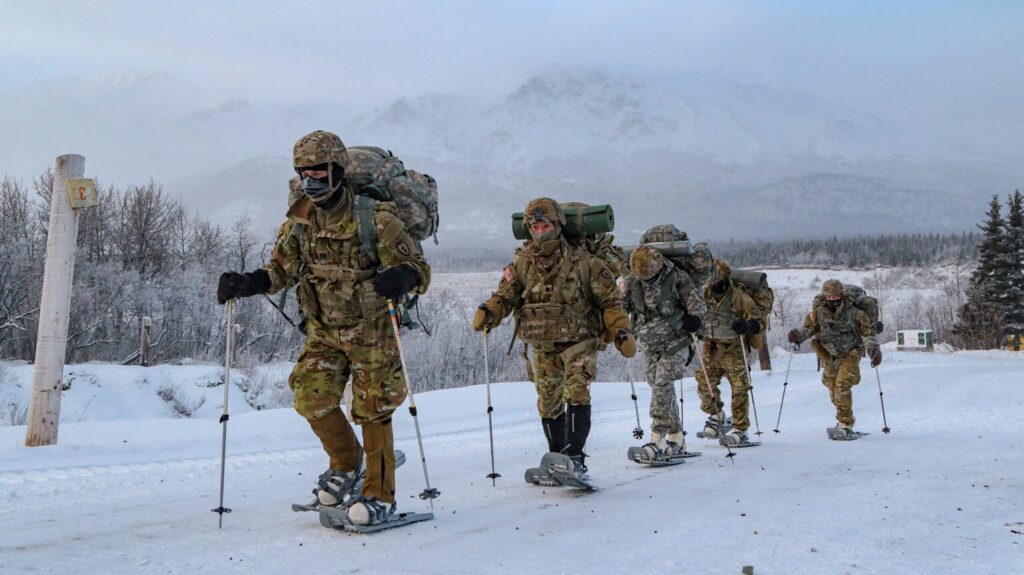Senior leaders from US Army Alaska travel from one training area to another training spot on snowshoes at Black Rapids Training Site Nov 17 as a part of their Cold Weather Orientation Course. (Sgt. Christopher Dennis/US Army)
WASHINGTON — Fresh off a NATO Summit featuring two new members hailing from the high north, the Pentagon today released its newest strategic document outlining the need for both the US and its allies to curb Russian and Chinese ambitions in the arctic.
The new document, the 2024 National Strategy for the Arctic Region, warns that both Moscow and Beijing are increasingly working together to facilitate their activities in the north, particularly in the wake of Russia’s invasion into Ukraine.
“Increasingly, the PRC and Russia are collaborating in the Arctic across multiple instruments of national power,” according to the document. “Russia’s isolation as a result of its full-scale invasion of Ukraine has made it increasingly reliant on the PRC for financing energy export infrastructure in the Arctic. Over 80 percent of Russia’s natural gas production and nearly 20 percent of its petroleum production comes from the Arctic, and Russia is increasingly turning to the PRC to fund this extraction and purchase these resources.”
RELATED: Admiral sounds alarm amid rising Russian, Chinese movement in high north
But in the same vein that Russia and China’s cooperation is increasing, the strategy notes that NATO’s newest members — Sweden and Finland — are both arctic nations with vast experience operating in the region and building ships that keep their ports clear of ice that would otherwise impede most vessels.
“The Arctic NATO Allies posses highly capable militaries, and thanks to longstanding cooperation, are all highly interoperable,” according to the strategy. “NATO’s enlargement, in addition to increasing Nordic defense cooperation, will create new opportunities for combined planning, information sharing, and exercises that will expand regional collaboration.”
Among other things, a key reason why international interest in the arctic has been rising in recent years is the Earth’s global warming, which is rapidly melting ice and in turn opening up new, useful sea lanes and commerce routes that countries such as Russia have already been eyeing for their own purposes.
“With climate change, our Arctic is becoming far more accessible,” Canadian Defense Minister Bill Blair said at the NATO Summit. “And we estimate that if we continue on the same path, and hopefully we won’t … by 2050, the Arctic Ocean could be primary point of transit between Europe and Asia. And as it becomes more accessible, security concerns become, I think, far more significant to us.”
Canada, the US and five other NATO allies — Denmark, Finland, Iceland, Sweden and Norway — as well as Russia are all part of the the Arctic Council, the international forum the countries use to sort out disagreements about the arctic amongst one another.
For its part, China has previously made claims of being “near-arctic state,” a title swiftly rejected by the US State Department at the time, but that has not curbed the country’s interest in the region.
Despite the rising temperatures, ice still remains one of the biggest dangers to any ship transiting the region. With that clearly in mind during the NATO Summit earlier this month, President Joe Biden, Canadian Prime Minister Justin Trudeau and Finnish President Alexander Stubb inked a new strategic agreement, dubbed ICE Pact, which promises the trio of nations will work together to build new heavy ice-breaking ships.
RELATED: US teams With Canada, Finland on polar icebreakers to chill Russian, Chinese power up north
While specific details of the pact have yet to be revealed, its trio of signatories combines two countries with massive experience designing, building and operating icebreakers — Finland and Canada — with the United States, which owns a relatively skeletal fleet of icebreakers but offers a significantly larger industrial base and budget to turbo boost the shipbuilding effort.
The American icebreaker fleet is managed by the Coast Guard and has just three ships to speak of — one of which is effectively non-operational due to how expensive it would be to bring it underway. Meanwhile, Canada and Finland both own between six and a dozen icebreakers. Canada is in the midst of recapitalizing its fleet while the Finnish are famous for producing the majority of ice-breaking ships operating around the world.











